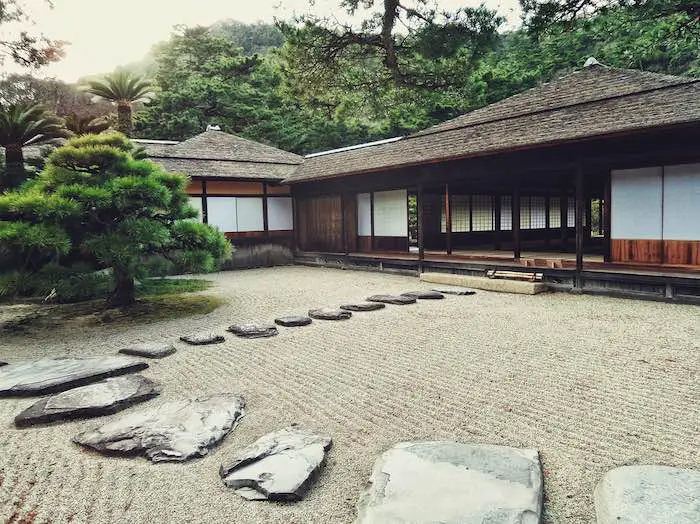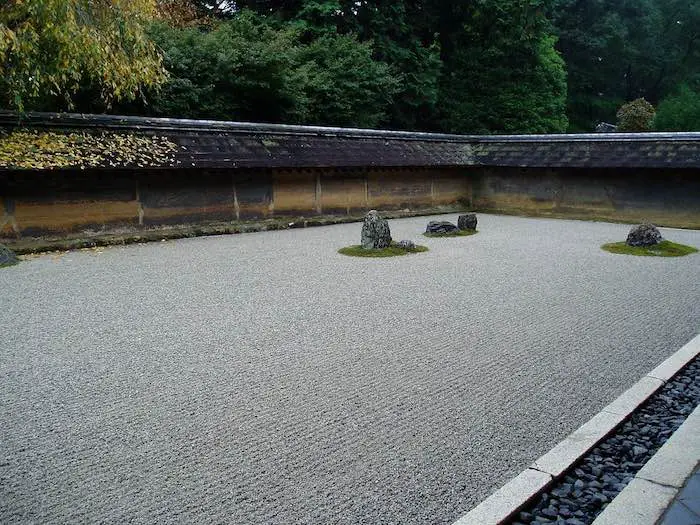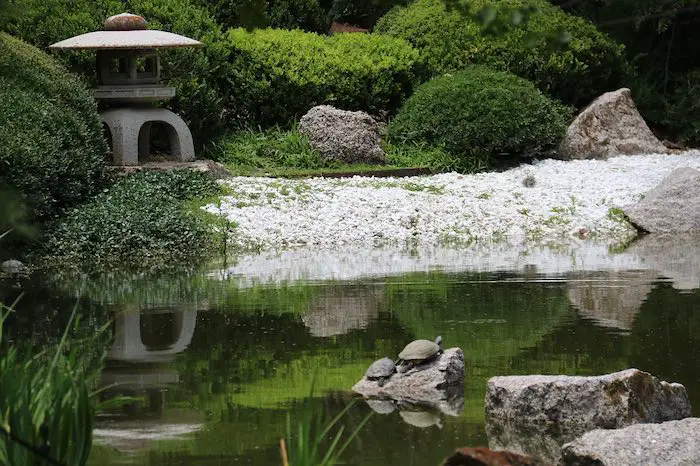You must have heard about ‘The Zen Life’ trending these days. Inspired by the teachings of the Zen Monks, it’s about leading a simple lifestyle with concentration and selflessness in every activity. Urban people are trying to incorporate the zen principles at home and work through various channels and one such method is building a Zen garden.
As good as it sounds, a Japanese zen garden is a great way to transform your landscape into an oasis of tranquility, peace, and meditation. It serves as a medium to disconnect you from the outside world as you step into your home, and establish the link with your inner self. It evokes a feeling of peace and reduces stress to promote psychological health benefits.
So, if you are planning to build a Zen garden from the scratch, we are here to help you. In this post, we have included all trifle and significant information that can play a role in transforming your space. Some people even recreate a zen garden indoors to add sophistication and elegance to the interior décor. One of the biggest advantages is that it requires so less maintenance.
So, whether you are planning to create an outdoor or indoor Zen garden at your home or office, read on to find out the essential things you will need. Also, take a look at the useful tips and ideas that can be handy.
7 Salient Aspects Of A Zen Garden
Zen gardens, also referred to as Japanese rock gardens, are sought after by house owners who like incorporate controlled settings of rocks and raked sand with soft-textured plants.
Originating in China, the Zen culture was popularized by Japanese before it became a worldwide obsession. The zen gardens serve as meditation tools that enable users to create a reflection of their personal space.
Anyone who feels that a natural woodland setting with precisely trimmed plants and wildflowers evokes serenity, they should think about creating a natural garden.
Zen accentuates the principles of simplicity (Kanso), naturalness (Shizen), and austerity (koko). The first-ever zen garden was created in the sixth century by Zen Buddhist monks to help in meditation.
The design and structure of the Zen gardens are refined over the years to match the requirements and tastes of the westerners, but the basic still remain the same.
The Zen gardens make use of gravel, stones, sand, and rocks to create a symphony of natural elements. A common feature of these gardens is the swirling pattern with lines that have a calming effect on the mind.
The act of raking patterns on the sand is believed to reflect the mind and help in bringing back the wandering mind to recreate peace within.
Six Things You Will Need To Create A Zen Garden
1. Sand or Gravel
You will need fine gravel, crushed granite, and small pebbles to be spread across a flat surface in a zen garden. These elements should be shaped angular instead of round to help you create beautiful patterns using a rake. You may use both varieties of dark and light sand or gravel to create a spectacular pattern.
2. Stone Forms
A Zen garden is incomplete without stones that are placed strategically on a flat surface to create beautiful forms that symbolize different meanings. The upright or vertically placed stones represent wood and trees, while the broad and flat stones stand for water.
Low lying vertical stones stand for metal, while the stones with an arching shape symbolize fire. The reclining stones are often used to create a sense of tranquility and relaxation. You may try out the different layouts to see which design and elements suit you best.
3. Rocks and boulders

Besides stones, rocks are also an important part of a zen garden. You will often find an interesting arrangement of rocks along with gravel and sand to create abstract representation. Sand often depicts water while rocks represent islands or mountains.
Sometimes the rocks may be arranged in a way to symbolize animals such as a crane or tortoise to symbolize longevity. The rocks used in Zen garden are typically dark or light gray wearing a battered appearance.
4. Vegetation
When it comes to incorporating plants, a zen landscape is very selective. It uses very less vegetation which may include lichen or moss. The most common types of plants used in zen gardens are the low spreading species.
The types of plants used are mostly woodland and evergreen varieties. Instead of large and bushy plants, the Zen garden usually includes neatly pruned shrubs as a border or accents.
5. Enclosures or borders
Some people prefer building a Zen garden within a proper enclosure to give you a sense of tranquility and privacy inside a garden. The enclosure may be in the form of a stone wall, a nice wooden gate, or a row of beautiful rocks or boulders to give a definition to the garden.
6. Additional Elements

The zen gardens may often contain some human-crafted elements to accentuate and add more life to space. These elements may include a few colored lanterns, a bridge, or a pathway. Creating a bridge allows people to see the garden in a whole new angle.
An arched bridge may consist of pebbles allowing the visitors to walk over them. A defined pathway may be made of fine gravel or low stepping stones to fit into the Zen art. Lanterns made of stone or wood further add more mysticism to the ambiance.
Steps to Help You Build A Zen Garden
Just like interior décor and design created with the same elements vary widely, the same applies to gardens. The size of the space available, design, budget, and elements used can bring about a lot of difference. If you choose to do-it-yourself, here are the steps to help you build a Zen garden:
Step 1: Create a blueprint based on the size of garden
When creating a blueprint for your zen garden, you will need to take into account the size and space available to work on. You will need to decide whether you want to use up the entire space or just a small section of the garden.
Interestingly, the concept of a zen garden is not limited to outdoor spaces anymore. People living in apartments and houses with limited space can create a small desktop zen garden for the table. A section of the backyard may also be used to transform into a zen space.
Step 2: A perfectly sized mold to hold the sand
One of the basic aspects of zen gardens is that they are mostly dry landscapes, so you need a lot of sand to build one. Even though the modern versions of the Zen garden come with a lot of different elements, sand still remains a basic aspect and you need a perfectly sized mold for it.
A mold is required to hold the sand together so that it does not get scattered around the space. The type of mold needed will depend on the size of your garden. We suggest that you use wooden or glass molds to keep the natural elements.
Step 3: Rake to create ripples in the sand

Zen living is all about simple art forms and it reflects in various aspects such as raked sands. You will need a good quality rake to create beautiful strokes on the sand to represent water ripples. You may use your imagination and creativity to come up with unique designs for your garden, and the change the look of it based on your mood.
Step 4: Make use of pebbles and stones
When you want to attain that perfect Japanese zen garden in your house, make the best use of shiny pebbles and stones. The key lies in knowing how to arrange them well in order to evoke a sense of calmness and tranquility.
You may submerge a few large rocks in the sands, but don’t overdo it or else the space may look cluttered. We suggest that you place the large rocks on the sides and use small stones and pebbles for decoration.
Step 5: Accentuate the Zen feeling(optional)
There are various elements that you may add to your Zen garden or inhouse space to accentuate that ‘Zen’ feeling. Although adding these items is not compulsory, you may benefit by including them in the space. These items include a statue, a stone lamp, rock boulders or anything unique and visually appealing. However, remember that this is optional.
Step 6: Create pathways and add plants
Next, you will need to add some plants but this doesn’t mean using only greens. You may also include some bright yellow blossoms to bring about a sense of positive energy. Besides the usual green shrubs and precisely trimmed bushes, you may also include dark green plants to balance the yin energy.
Some people prefer to create zen gardens with just sand, gravel, and stones, but we suggest adding trees and plants for a soothing feel. If you have a large garden area, create pathways that go through space to take you to any section of the garden. Create borders or add a gate as you please to make your garden more attractive.
Step 7: Use of lights (optional)
Again, this is not a requirement for a zen garden but we feel it has a practical use to make your garden look attractive and accessible at night. Soft lights with shadows falling on the stones and rocks will create a lovely symphony, making your garden stand out.
Step 8: Water body (optional)

Most zen gardens are dry, but the modern versions may include a water body to enhance beauty. Although this is not a prerequisite, you may add one if possible. For example, if your landscape has a pre-existing pond or water fountain, you may consider building a garden around it.
Some house owners prefer adding a water element to their garden if it does not exist already. Water adds positive energy to the surroundings and retains them too.
Step 9: A large structure (optional)
If you are lucky to have a large piece of land that you can transform into a Zen space then make the best use by adding some bigger details. You may take the help of professional landscapers to help you design the space with a nice focal point, which could be a pagoda, gazebo, or pergola.
You may consider adding a few other structures such as an arch bridge or a wooden bench for people to sit and enjoy some peaceful and tranquil moments with self.
Create A Tabletop Zen Or Desktop Zen Garden
One of the biggest reasons behind the popularity of zen gardens is their versatility. You don’t really require a sprawling garden or a large backyard or patio to build a zen garden. It can be easily and successfully be translated into a much smaller scale to deliver similar benefits.
Even in a much smaller scale, when you create a tabletop or desktop zen garden, it serves as a perfect reminder to tell you to slow down and smell the flowers. It’s about taking pleasure in small and simple things, and search within for the oasis of peace.
If you live in a small city apartment or stay enclosed in your office or workspace all the time, you do not have to deprive yourself from the joy of a zen garden. You just need a few things to recreate a small zen space in your work area or in your living room. Here are a few things you will need:
- A small mold made of wood or glass to place some sand
- Use a few white stones, gray pebbles, and small rocks
- Add a pop of color with succulents or bonsai
- Place a small Buddha figurine
- Color a small rock or stone and write words like Zen or Namaste
- Rake the sand with a fork or create interesting designs using different stones
By adding a mini zen desktop garden or zen tabletop, you will not only enhance the interiors of your house but also make your workspace more peaceful. Put it on your office desk to calm down and deal with the stress at work. It helps you take some time out from the busy schedule and derive pleasure by simply looking at the tiny zen garden.
Six Benefits Of A Building Zen Garden
There comes a time in every person’s life when we feel alienated from our own self and feel the need to reconnect to the inner soul. By creating a zen garden outdoor or inculcating a miniature version of it indoors, you can enjoy the various benefits as mentioned below:
Relieve Stress and Anxiety
Reducing stress and relaxing the mind is one of the biggest benefits of creating a zen garden. Raking the sand to create water ripples as per your mood and arranging the stones in different ways are great ways to minimize anxiety.
Increases concentration
The repetitive movements used in creating a zen garden helps in improving concentration and focus in the present. It allows you to let go of the past and stop worrying about what the future holds. Thus, it lets your mind escape and feel free.
Helps in meditation
The calm and serene environment and minimalist surroundings of a zen garden can help you see the wider perspective of things and find solutions for difficult things. It lets you practice mindful breathing to purge out the toxic thoughts from within.
Boosts problem-solving skills
It not only improves meditation skills, but you will also feel more peace with yourself and be able to find solutions for things faster than before. Thus, a desktop zen garden at the office can increase your efficiency at work and save time too.
Stimulates Creativity
If you feel that your mind is too packed up with things to allow creativity to thrive then a zen garden can pull out the stops. You can feel its impact on your creativity and thinking. With focus and meditation, you will improve the fertile inner space to grow new ideas and let the thoughts flow.
Facelifts your home
Whether you transform your front space or backyard into a zen garden or build an indoor zen desktop for home or office, it enhances the décor and brings in a balance. It uses the Japanese concepts of Fukinsei and Kanso to create a sense of grace and appeal. It also improves feng shui in your home and enhances the overall appeal.
Related Questions
What does a mini zen garden kit include
If you are a beginner trying your hand at creating a desktop or tabletop zen garden, we suggest that you use one of the mini zen garden kits (see Amazon) you can find online. These kits may include objects like a wooden tray, sand, stones, and a rake. A few kits may also include décor items like a Buddha statue, candle or incense sticks holder.
How to transform a sandpit into a Zen garden
If there are kids at home, you still stand a chance to enjoy creating a zen space. You may use a sandpit that the kids like to play in to serve as a zen space. After a play session, carefully rake the sand and put back the decorative stones to have your tranquil corner ready.
What is are the good plants for a zen garden
We suggest that you use plants with subtle tones because the ones with loud and lively hues are not the best fit for a zen space. When you take loud colors out of the palate, eyes start contemplating the placement, texture, and depth.
We suggest foliage colors in varying shades of soft blues, greens, or darker reds. You may blend the different shapes and textures, or create a more repetitive design to improve concentration. Some unique ideas include moss logs, bonsai plants, and succulents.
The post A Zen Garden: All You Need To Know appeared first on Homelization.
A Zen Garden: All You Need To Know was first posted on at .
©2019 "Homelization". Use of this feed is for personal non-commercial use only. If you are not reading this article in your feed reader, then the site is guilty of copyright infringement. Please contact me at info@homelization.com
